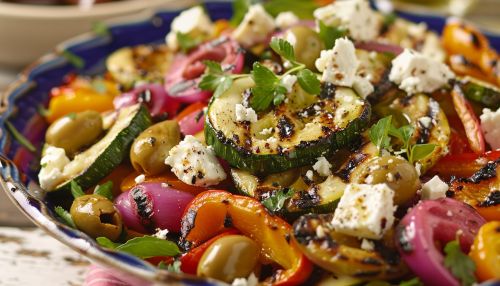Mediterranean cuisine
Introduction
Mediterranean cuisine refers to the culinary traditions and practices of the countries surrounding the Mediterranean Sea. This region includes Southern Europe, parts of North Africa, and the Middle East. The cuisine is known for its diversity, rich flavors, and health benefits, attributed to the use of fresh ingredients such as olive oil, vegetables, fruits, legumes, nuts, and seafood. The Mediterranean diet has been extensively studied for its positive impact on cardiovascular health and longevity.
Historical Background
The origins of Mediterranean cuisine can be traced back to ancient civilizations such as the Greeks, Romans, and Phoenicians. These cultures laid the foundation for the culinary practices seen today. The Ancient Greeks introduced the cultivation of olives and grapes, which are central to Mediterranean cuisine. The Romans expanded the use of herbs and spices, while the Phoenicians contributed to the spread of various grains and legumes.
Key Ingredients
Olive Oil
Olive oil is a staple in Mediterranean cuisine, used for cooking, dressing salads, and as a condiment. It is rich in monounsaturated fats and antioxidants, which contribute to its health benefits. The quality of olive oil can vary, with extra virgin olive oil being the highest grade, obtained from the first pressing of olives without the use of heat or chemicals.
Vegetables and Fruits
Vegetables such as tomatoes, eggplants, zucchini, and bell peppers are commonly used in Mediterranean dishes. Fruits like figs, pomegranates, and citrus fruits are also prevalent. These ingredients are often consumed fresh, grilled, or roasted, and are essential for their vitamins, minerals, and fiber content.
Legumes
Legumes, including lentils, chickpeas, and beans, are a significant source of protein and fiber in Mediterranean cuisine. They are used in a variety of dishes such as hummus, falafel, and stews.
Seafood
The Mediterranean Sea provides an abundant supply of seafood, which is a key component of the diet. Fish such as sardines, mackerel, and anchovies are rich in omega-3 fatty acids, which are beneficial for heart health. Shellfish, octopus, and squid are also commonly consumed.
Herbs and Spices
Herbs like oregano, basil, thyme, and rosemary are used to flavor dishes, while spices such as cumin, coriander, and saffron add depth and complexity. These seasonings are often used fresh or dried and are integral to the region's culinary identity.


Regional Variations
Southern Europe
Southern European countries such as Italy, Spain, and Greece have distinct culinary traditions. Italian cuisine is known for its pasta, risotto, and pizza, while Spanish cuisine features tapas, paella, and gazpacho. Greek cuisine includes dishes like moussaka, souvlaki, and tzatziki.
North Africa
North African cuisine, including Moroccan, Tunisian, and Algerian food, is characterized by the use of spices like cumin, coriander, and cinnamon. Dishes such as couscous, tagine, and harira are popular. The influence of Berber, Arab, and French culinary traditions is evident in the region's diverse food culture.
Middle East
Middle Eastern cuisine encompasses a wide range of dishes from countries like Lebanon, Israel, and Turkey. Common foods include kebabs, falafel, tabbouleh, and baklava. The use of tahini, yogurt, and pomegranate molasses is prevalent, adding unique flavors to the cuisine.
Health Benefits
The Mediterranean diet has been extensively researched for its health benefits. Studies have shown that it can reduce the risk of cardiovascular disease, type 2 diabetes, and certain cancers. The diet's emphasis on plant-based foods, healthy fats, and lean proteins contributes to its positive impact on health. Additionally, the moderate consumption of red wine, which is rich in antioxidants, is associated with reduced inflammation and improved heart health.
Culinary Techniques
Grilling and Roasting
Grilling and roasting are common cooking methods in Mediterranean cuisine, used to prepare vegetables, meats, and seafood. These techniques enhance the natural flavors of the ingredients and often involve the use of olive oil and herbs.
Stewing and Braising
Stewing and braising are used to create rich, flavorful dishes such as tagines and stews. These methods involve slow cooking ingredients in a liquid, allowing the flavors to meld together over time.
Baking
Baking is another essential technique, used for making bread, pastries, and casseroles. Traditional Mediterranean breads like pita, focaccia, and ciabatta are staples in the diet.
Cultural Significance
Food plays a central role in Mediterranean culture, often associated with social gatherings and celebrations. Meals are seen as an opportunity to connect with family and friends, and the act of sharing food is deeply ingrained in the region's traditions. Festivals and religious observances frequently feature specific dishes that hold cultural and symbolic significance.
Modern Adaptations
In recent years, Mediterranean cuisine has gained popularity worldwide, leading to modern adaptations and fusion dishes. Chefs and home cooks alike have embraced the principles of the Mediterranean diet, incorporating its ingredients and techniques into their culinary repertoire. This global influence has helped to spread awareness of the health benefits and rich flavors of Mediterranean cuisine.
